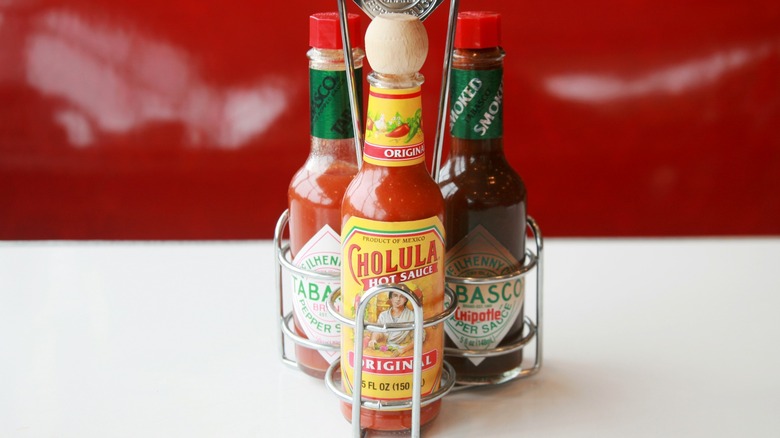Why You Should Always Pass On Bottled Hot Sauce At Mexican Restaurants
Condiments can improve many dishes, complimenting and deepening their flavors to create an altogether richer dining experience. But the wrong condiment can also undercut the taste and appeal of certain food, especially those with diverse or complex ingredients. To that end, Maycoll Calderón, the executive chef of Cuna at The Standard East Village, noted that one thing you should avoid doing at a Mexican restaurant is drenching your meal in bottled hot sauce.
Some foods, like pizza, can be complemented by hot sauce on occasion. Yet, when sampling the fare at a Mexican restaurant for the first time, folks should taste what's brought to their table before doctoring up the dish. "A great taco, molé, or ceviche already has balance — acidity, spice, salt, and freshness," says Calderón. "Adding bottled sauce often covers the subtle layers we've built in the kitchen."
Rarely are the bottled hot sauce choices at a restaurant as fiery as the five-alarm concoctions advertised on Hot Ones, but even mild varieties can sometimes be potent. "Bottled hot sauce can overpower the natural flavor of a dish," notes Calderón. You're paying for exceptional Mexican cuisine, not hot sauce. Calderón argues that drowning your meal in hot sauce at a Mexican restaurant is akin to committing the cardinal sin (in this writer's mind, at least) while dining at a quality steakhouse: "It's like putting ketchup on a perfectly cooked steak."
Skip the bottled hot sauce and go for the salsa
Drenching food you receive from a Mexican restaurant in bottled hot sauce is a faux pas, but that doesn't mean that you should avoid all the condiments presented to you. Maycoll Calderón mentions salsa as a terrific example of this. "Most good Mexican restaurants make their own salsas daily," he says. "Each one has a purpose: a green tomatillo salsa for freshness and acidity, a red chile de árbol salsa for heat, or a roasted salsa for smokiness."
The chefs who create the salsa recipes understand how the condiment will balance with the rest of the food they are delivering guests (though there are salsa-related red flags to look for when dining at Mexican restaurants). The flavors are intentional and serve to elevate other menu items. "They're meant to complement, not mask, the dish," explains Calderón. "It's about enhancing, not hiding." While it's not always the case, bottled hot sauce can often obscure the flavors a dish is meant to transmit to the taste buds. It doesn't make much sense to go out of your way to spend hard-earned dough at a Mexican restaurant if you're going to drown out the flavors it's trying to showcase to diners.

